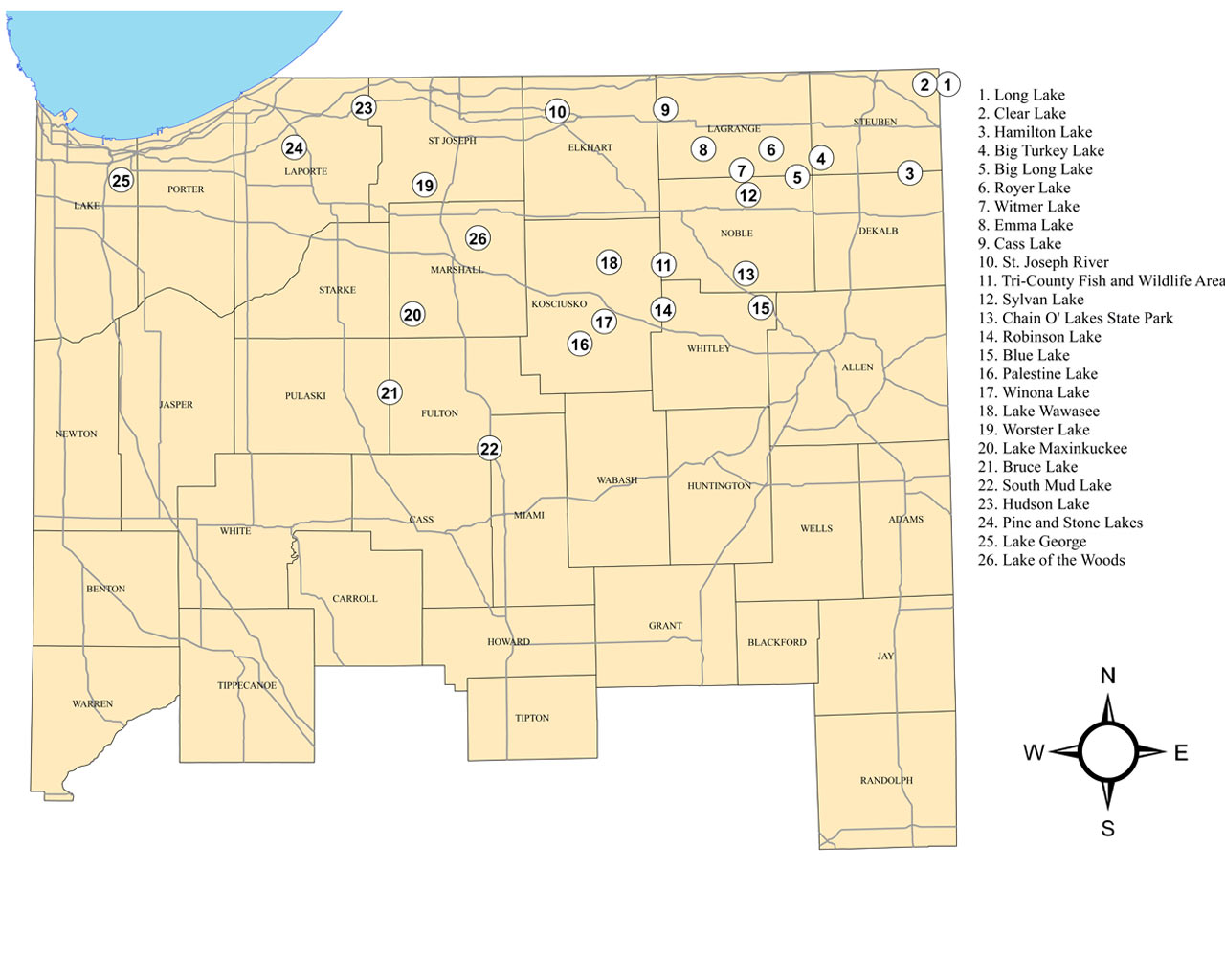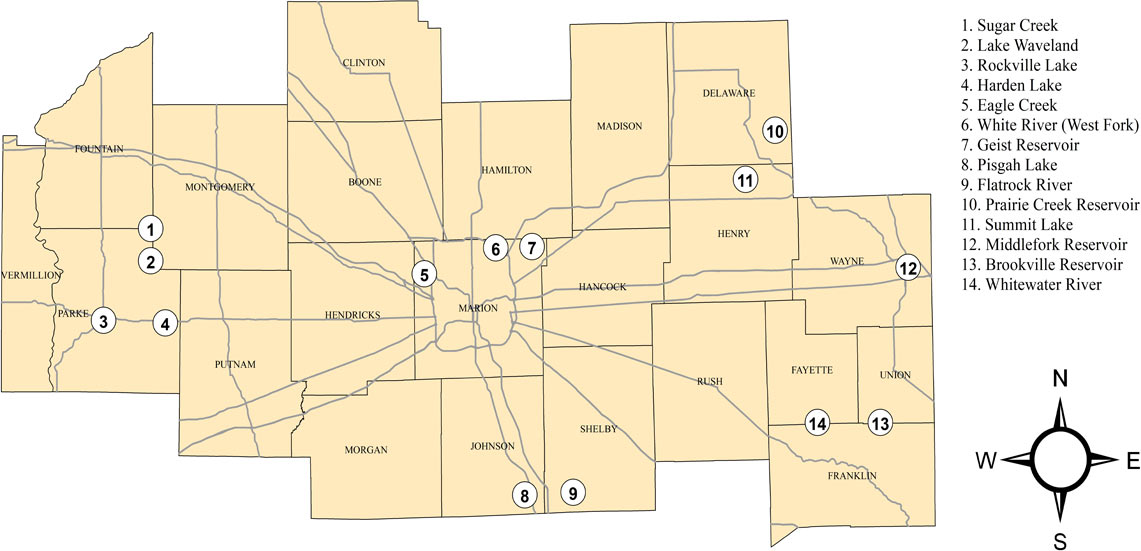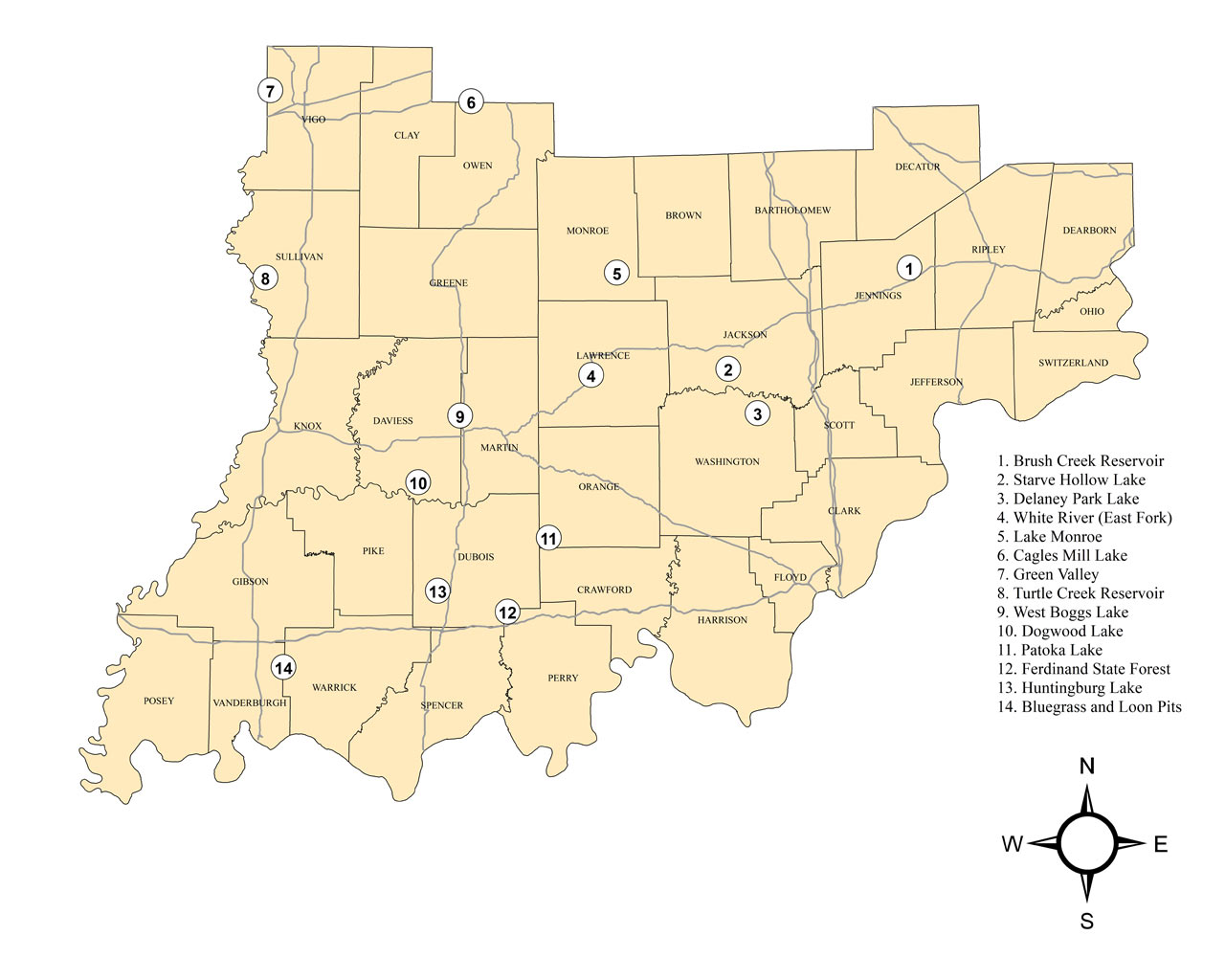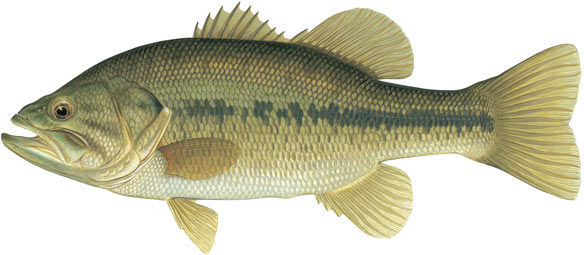
Artwork by Rick Hill Kentucky Department of Fish and Wildlife Resources.
Overview
Largemouth bass (Micropterus salmoides; hereafter referred to as largemouth) are generally olive green overall with a cream-colored belly and a series of black blotches that form a line along the side. Its upper jaw extends beyond the rear part of the eye and has no tooth patch present on the tongue. The dorsal fin (fin along the backbone) is nearly separated and has spiny and soft sections.
Largemouth can be found in nearly all Indiana waterbody types including ponds, lakes, reservoirs, streams, and rivers. Juvenile largemouth eat crustaceans, insects, and insect larvae, while adults primarily feed on fish, crayfish, and large insects. Indiana largemouth typically grow 3 to 4 inches per year for the first three years, then 1 to 2 inches per year through age 8, and less than 1 inch per year after age 8.
Largemouth begin spawning in the spring after the water temperature has reached approximately 65°F. Nests are built by the males in water anywhere from 1 to 15 feet deep but are typically located in water less than 5 feet deep. Almost any type of bottom may be used for nesting, but gravel is preferred. The eggs are fertilized by the male as they are deposited onto the nest. The eggs typically hatch in three to four days depending on water temperature. The fry begin to feed five to eight days after hatching and remain in a tight school until 26 to 31 days after hatching (when they are about one inch long). The male largemouth remains near the schooling fry, protecting them from predation.
Habitat
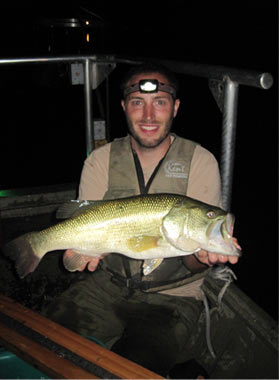 DNR fisheries management staff completing a nighttime electrofishing survey at Little Long Lake (Noble County). Largemouth prefer warm, moderately clear waters that do not have a noticeable current. Aquatic vegetation and woody debris are necessary components of high-quality habitat for largemouth. The littoral zone is the shallow nearshore area where there is enough light for aquatic vegetation to grow. Approximately half of a typical Indiana glacial lake littoral zone contains submerged aquatic vegetation, while vegetation is less prevalent in reservoirs.
DNR fisheries management staff completing a nighttime electrofishing survey at Little Long Lake (Noble County). Largemouth prefer warm, moderately clear waters that do not have a noticeable current. Aquatic vegetation and woody debris are necessary components of high-quality habitat for largemouth. The littoral zone is the shallow nearshore area where there is enough light for aquatic vegetation to grow. Approximately half of a typical Indiana glacial lake littoral zone contains submerged aquatic vegetation, while vegetation is less prevalent in reservoirs.
Management
Indiana Department of Natural Resources (DNR) fisheries biologists manage largemouth in public waterbodies by evaluating data collected during fisheries surveys and angler creel surveys to determine if management actions are required. Since 2010, fisheries biologists have completed more than 200 general fish community and targeted largemouth surveys to monitor populations. Creel surveys indicate that largemouth are one of the most popular sportfish among Indiana anglers. In fact, approximately one-third of all Indiana anglers target largemouth. Fishing tournaments for largemouth are also popular on Indiana waterbodies. Fishing tournaments on DNR properties with 15 or more watercraft are required to obtain a fishing tournament permit.
The majority of largemouth in Indiana waterbodies fall under three statewide black bass regulations; however, there are special regulations on a select group of waterbodies. To learn more about largemouth regulations, visit the Fishing Guide and Regulations webpage.
Fish Stocking FAQs
- Why isn’t DNR stocking largemouth bass?
The DNR stocks very few of our naturally reproducing species anywhere in the state because these fish can naturally sustain their own population levels for the water body they live in. Several studies from other states have found that stocked largemouth either disappear after two years or outcompete and replace the natural stock. The end result in both instances is that there are no changes to overall largemouth numbers in the lake.
- Why are you stocking fish that are not largemouth bass?
DNR stocks predator species such as walleye, muskellunge, hybrid striped bass, and striped bass to provide unique fishing experiences for Hoosiers. The DNR stocks these predator species across the state because these fish have very limited or no natural reproduction in our waters. Without regular stockings of these species, their populations would cease to exist or be at such a low level they would rarely be caught.
- What else is DNR doing to support largemouth bass populations?
Where largemouth populations are low and habitat is limiting, DNR is using artificial fish structures to supplement the available natural habitat and to provide known good fishing locations to help improve angler catch rates. In addition to improving habitat for largemouth, these habitat enhancements will also benefit other commonly caught species like bluegill, catfish, and crappie. To view all the lakes where habitat work has either been completed or is ongoing, visit our interactive reservoir habitat map.
Tri Lakes Largemouth Bass Project
 This spring, the Indiana DNR will host an open meeting in conjunction with the Tri Lakes Association to discuss an increase in fisheries management on the lakes. Currently, Tri Lakes has an abundance of small bass with most being between 8.0 to 13.5 inches in length. Growth of these fish is well below average compared to other lakes in the area.
This spring, the Indiana DNR will host an open meeting in conjunction with the Tri Lakes Association to discuss an increase in fisheries management on the lakes. Currently, Tri Lakes has an abundance of small bass with most being between 8.0 to 13.5 inches in length. Growth of these fish is well below average compared to other lakes in the area.
To address this, the Indiana DNR plans to remove approximately 1,000 small bass per year for five years and relocate those fish to nearby J.E. Roush Lake, where the density of largemouth bass is low. Starting this May, fish will be collected each May using electrofishing techniques, and they will then be transferred in DNR fish stocking trucks to J.E. Roush Lake. The quantity of fish collected per year may be adjusted as needed, depending on the estimated population size for Tri Lake each year.
These changes in small-bass management will allow Tri Lakes to become a more balanced fishery while improving the opportunity for bass fishing at J.E. Roush Lake. To ensure this practice is done safely, DNR has conducted fish disease testing at both Tri Lake and J.E. Roush Lake. There have been no concerning findings. Biologists will conduct regular surveys throughout the process, not only for largemouth bass, but also for all other species in the lake to help ensure that no negative impacts occur.
In May of 2024, 955 largemouth bass were relocated from Tri-Lakes to J.E. Roush Lake in Huntington. The bass ranged in size from 6.2 inches to 13.9 inches in length. The average size of the bass removed was 10.2 inches long. A second round of relocations, along with a survey, will occur in May of 2025.
State Record Fish and Fish of the Year Program
The Division of Fish & Wildlife sponsors two award programs recognizing outstanding catches by sport anglers. The Indiana Record Fish Program recognizes new state record catches. The Fish of the Year program recognizes anglers who catch the largest fish of each species that is smaller than the current state record. Weight is the measurement used for state record fish. Total length is used for Fish of the Year catches.

